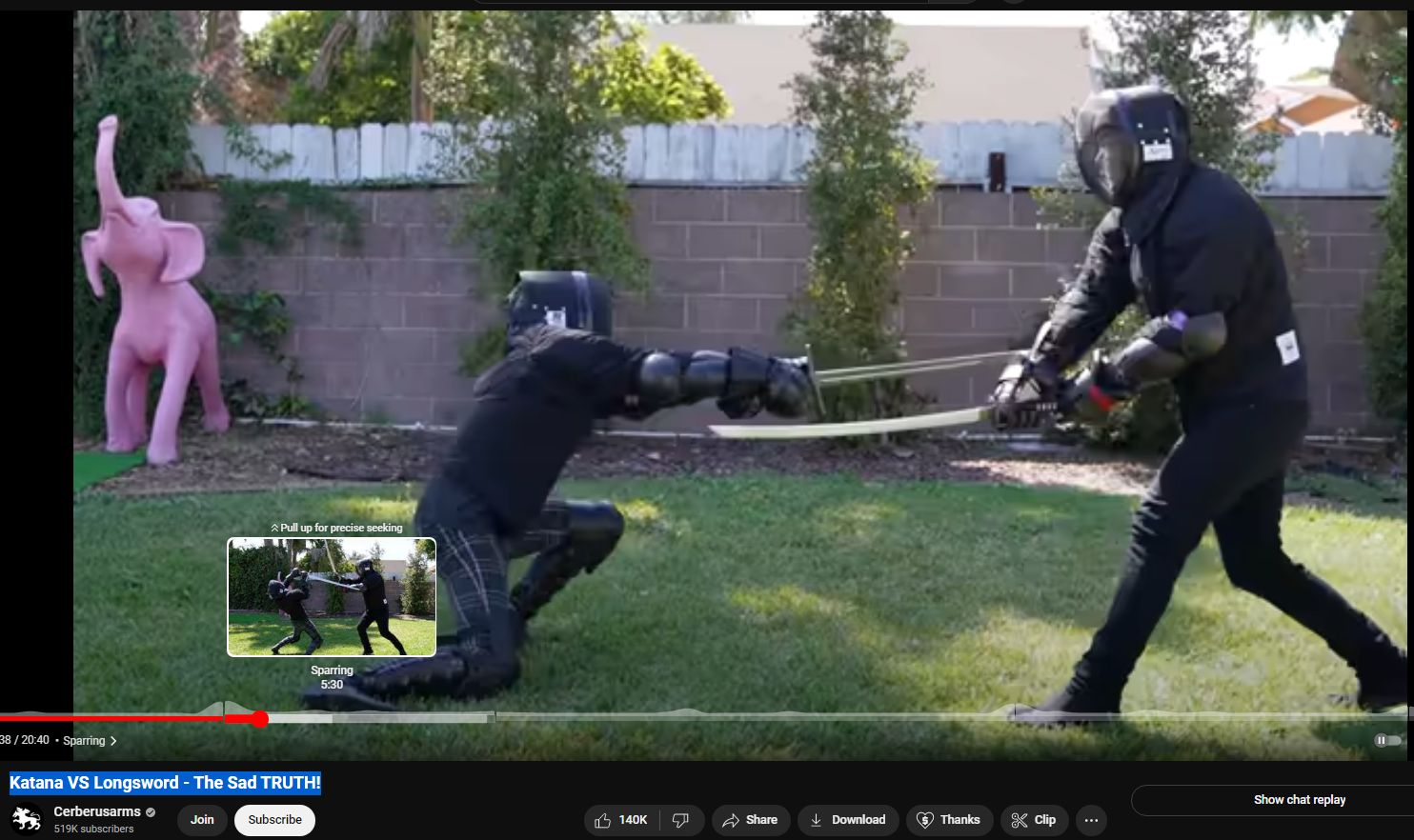Swords do not cut Swords – Steel does not cut Steel – Katana vs Long Sword
https://www.youtube.com/watch?v=WBESIyEInW0
Katana vs. Longsword: Exploring the Differences in Two Iconic Swords
Swords have long captured the imagination of history enthusiasts, martial artists, and fans of medieval weaponry. Among the most iconic swords in history are the katana from Japan and the longsword from Europe. In this blog post, we’ll delve into the differences between these two legendary swords, examining their design, functionality, cultural significance, and combat techniques.

Origins and Cultural Significance
1. Katana:
The katana is a traditional Japanese sword that emerged during the feudal period. It is characterized by its curved, single-edged blade and slender profile. The katana holds immense cultural significance in Japanese history and samurai tradition, symbolizing honor, discipline, and martial prowess.
2. Longsword:
The longsword, also known as the hand-and-a-half sword, is a European sword that gained prominence during the medieval era. It features a straight, double-edged blade and a longer grip that allows for versatile two-handed or one-handed use. The longsword played a crucial role in European knightly combat and fencing traditions.
Design and Construction
1. Katana:
– Blade: The katana’s blade is typically made from high-carbon steel, folded multiple times to achieve a sharp edge and resilient core. It has a distinctive curve known as the “sori,” which enhances cutting efficiency.
– Guard and Grip: The katana’s guard (tsuba) is often minimalist in design, focusing on functionality rather than ornate decoration. The grip (tsuka) is wrapped with traditional materials like silk or leather for a secure hold.
2. Longsword:
– Blade: The longsword’s blade is usually straight and double-edged, designed for thrusting, cutting, and slashing maneuvers. It is crafted from high-quality steel, with variations in blade length and width based on historical and regional preferences.
– Guard and Grip: Longswords feature elaborate handguards (quillons) that provide protection for the wielder’s hands during combat. The grip is longer than that of a katana, accommodating both one-handed and two-handed grips.
Combat Techniques and Usage
1. Katana:
– Techniques: The katana is renowned for its precise cutting techniques, including diagonal slashes (kesa-giri), horizontal cuts (suji-giri), and overhead strikes (kiri-age). It is often used in conjunction with a smaller companion sword called a wakizashi in the samurai’s daisho pairing.
– Combat Style: The katana’s combat style emphasizes agility, speed, and fluid motion. Samurai warriors trained extensively in the art of iaido (sword drawing) and kenjutsu (swordsmanship) to master the katana’s techniques.
2. Longsword:
– Techniques: Longsword techniques encompass a wide range of offensive and defensive maneuvers, including thrusts, cuts, parries, and binds. Longsword fencing systems such as German Fechtbuch and Italian Fior di Battaglia document various techniques and strategies.
– Combat Style: Longsword combat involves a combination of footwork, blade control, and strategic positioning. Fighters employ both offensive actions (attacks) and defensive actions (blocks, parries) to gain advantage in combat.
Conclusion: A Tale of Two Swords
In comparing the katana and longsword, we discover two remarkable swords with distinct characteristics, histories, and combat styles. While the katana represents the elegance and discipline of Japanese swordsmanship, the longsword embodies the versatility and sophistication of European knightly combat. Both swords have left an indelible mark on martial arts, culture, and popular imagination, showcasing the rich diversity and artistry of swordcraft throughout history. Whether you’re drawn to the precision of a katana’s cut or the power of a longsword’s thrust, these iconic swords continue to inspire admiration and fascination among enthusiasts of the blade.
Steel does not cut, pierce or slice steel — Swords do not cut swords — History provides zero examples
The idea of equal-hardness materials piercing, cutting, or slicing each other is indeed a topic of interest in material science and engineering. Here are some key points and examples that illustrate the difficulty, if not the impossibility, of such phenomena:
- Steel Cutting Steel:
- In general, for steel to cut through steel, the cutting steel must be harder than the steel being cut. This is typically achieved through tools that are specially treated or coated to increase their hardness. For instance, industrial cutting tools like carbide-tipped blades or diamond-coated tools can cut through steel because they are significantly harder than the steel they cut.
- High-speed steel (HSS) tools used in machining are much harder than the materials they cut. These tools are hardened through heat treatment and sometimes coated with materials like titanium nitride to further increase their hardness and cutting ability.
- Swords Cutting Swords:
- Historical accounts and practical demonstrations of swords cutting through other swords are rare and often mythologized. In reality, when swords clash, they tend to chip, notch, or deform rather than cleanly slice through each other. Swords are typically made from high-carbon steel, which balances hardness and flexibility. During a duel, a sword striking another sword will often result in damage to both blades, rather than one slicing through the other.
- Metallurgical advancements have created swords that are tougher and more resistant to damage, but even these modern swords cannot cleanly slice through another sword of equal hardness without sustaining damage.
- Structural Steel Slicing Structural Steel:
- Structural steel used in buildings and bridges is designed for strength and durability, not cutting ability. When structural steel components interact, such as during construction or demolition, cutting is achieved using specialized equipment like oxy-fuel torches, plasma cutters, or industrial saws. These tools operate by heating the steel to a point where it can be cut or using materials harder than the steel itself to achieve the cut.
- In scenarios involving structural failure or collisions, structural steel may bend, twist, or shear, but it does not cleanly slice through another piece of structural steel. The forces involved typically cause deformation or fracturing rather than slicing.
Conclusion
In essence, for one piece of material to cut, pierce, or slice through another, it must be harder than the material being cut. Equal-hardness materials typically do not cut through each other but rather deform, chip, or cause other forms of damage. This principle holds true in examples involving steel cutting steel, swords cutting swords, and structural steel slicing structural steel.
See also Baltimore Key Bridge #38 – Structural Steel Girders Slice Through Steel Hull Like Hot Knife Thru Butter for the single, sole, only known example of such in history, very strongly implicating the use of Directed Energy Weapons as alternate source of necessary energy.
Founder Of Architects & Engineers for 9/11 Truth Answers Whether Jet Fuel Can Melt Steel Beams
Brookhaven Natl Labs federal lawsuit against 200+ families for tritium contamination of local water. Turns out RHIC “ion gun” particle blaster creates tritium as biproduct. Tritium at WTC perfectly explained by the RHIC “ion-gun” particle beam weapon that is 61.1 miles away at an angle of 119 degrees and headquartered (on BNL campus) in building 911. Do you have eyes to see? RHIC’s interconnected NSLS was used to blast a tunnel in the atmosphere thru which the particle beam was fired, at the top of the Woolworth Building (which was subsequently closed for 10 suspicious years following 911 for repair of damages sustained during that event); the beam was collimated and swept vertically (up/down the WTC towers) via apparatus hidden within the unusually steep copper roof. This provided the particle beam called for in Hutchison Effect as particle emissions. The microwaves were provided by airborne redirectors. You can still listen to Melissa Doi be cooked alive during her 9-1-1 call for help from within the WTC — she complains of high-heat without fire, of so much smoke that she “can’t see air anymore” as the microwaves greyed-out her corneas with insta-cataracts (well-known side-effect of battlefield microwave weaponry). The high-voltage gradient field, also called for by Hutchison Effect, was provided by the super-secret Class-3 monster Hurricane Erin, which was directed directly at NYC for 2 weeks prior, then made to stand-still just 200 miles east (providing the thunder reported by all 3 local airports). This was a multi-disciplinary well-orchestrated attack whose advanced technologies are so far beyond the bailiwick of most humans and even scientists that it is hard to fathom. But, as we collectively gather clues and scratch out a diagram from connected dots, we can begin to understand how practically the entire world was duped yet again, and is still being largely duped up to this very moment.
“A river of steel, flowing” meantioned at 2:40 hearkens directly to the predictive-programming embedded in the Ghostbusters-2 movie — remember the river of lava-looking redish orange goop flowing beneath the skyscraper?
You can always tell the decepticon limited-hangouts like this Richard Gage guy and his merry troupe of archi and engi, because they don’t go anywhere with anything new. They just harp on their entrenched position, trying to swap crumbs and scabs, wasting time, effort, breath, life. What compels is the fresh insight, the new information that effortlessly and fully and obvious explains all evidence and data, new present and any future. The sole explanation that does so is called HUTCHISON EFFECT as best represented by Dr Judy Wood and Andrew Johnson.
